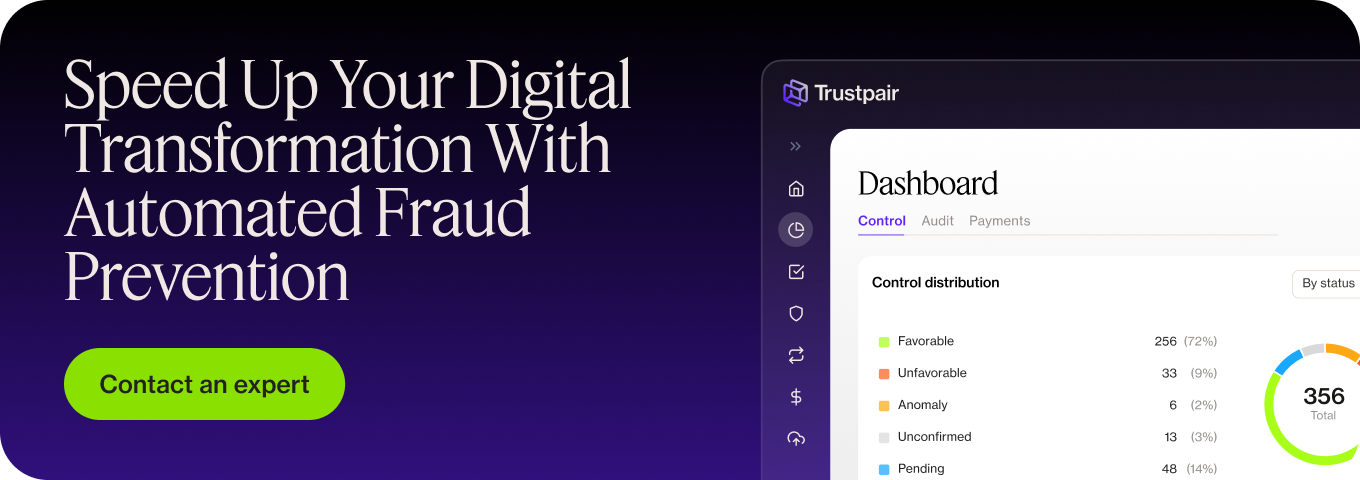Robotic process automation (RPA) enables companies to scale their work, save on costs, and reduce the risks of fraud. More businesses across the US have invested in RPA than in the Internet of Things, cloud computing, AI analytics, and the blockchain. From a business sense, the finance and time spent getting RPA up and running seem to pay back in most cases, with 81% of the companies investing in RPA having done so to achieve their financial goals.
Trustpair is one example of an RPA strategy; it automates fraud prevention and detection without errors thanks to continuous account validation. To experience the benefits of digitalization with Trustpair, contact an expert!
1. Increased efficiency
RPA enables companies to work with accuracy. This means zero chance of human error, and far more control over both the processes, and their results. In huge and complicated information sets like transaction data, this can make a real difference to manage accounts and processing in this way.
Forget the double checking of manual work, and use RPA to skip all that back-and-forth investigation into results that just don’t add up.
For example, RPA can be programmed by accounting to analyze historical patterns in your company’s financial data, through statements and banking information. By looking at this data and determining the trends, the RPA can then forecast the business’ future finances.
Relying on robots to manage and perform these types of processes can be beneficial. Indeed, it can be done much quicker than human calculations and analysis. Moreover, just a small error can set the process back, or worse, lead to the wrong outcomes. Since financial forecasting directly indicates how the business will operate over the coming quarters, a significant miscalculation could throw off the entire operation.
Since robotic process services offer higher accuracy over the long term, they benefit organizations to work quickly, and without error. RPA’s finance digitization capabilities lead to more efficiency over menial tasks.
2. It helps your auditors
Another benefit of RPA is that it can seriously help out external parties that don’t necessarily know the way things work around your business. This is particularly useful for finance automation. Auditors, for example, only have a small window to verify all of the documents, validating that your financial processes hold up.
RPA can help out auditors by:
- Streamlining accounting processes
- Standardizing any incoming data for smooth integrations
- Maintaining customer and vendor records
- Automate financial reporting
The biggest advantage to using RPA for these purposes is to make things that much easier when tax season rolls around. Auditors will be able to easily follow the trail from sale to invoice, payment to delivery notices, and reporting, thanks to the specific robots involved.
3. Reduced operating costs
Moreover, RPA can help organizations to reduce their overall operational expenses, thanks to smart software. Replacing manual labor with repetitive tasks means that your team members can focus their attention on the work that really matters.
For example, let’s imagine a lending company. By relying on RPA to pull out the open banking data that advisors need, they can make instant decisions on an applicant’s affordability. Without such technology, the advisor is required to go back and forth to collect this information themself, often relying on inaccurate information from the customer’s memory.
RPA has successfully been shown to fulfill this benefit, with an average of 59% reduction in operating costs across global RPA business users. What’s more, the technology can run 24 hours per day without the normal sleep needs of a human, or their salary costs.
These cases of success can be achieved by replicating the above example across all departments (including finance process automation). Here are some more examples:
| Process | Without RPA | With RPA |
| Form filling | Manual, requiring an employee to type out each of the fields | Robots can remember sets of information and automatically fill out forms on behalf of specific employees, or the company |
| Onboarding | Typically requires somebody in a senior role (ie a manager or executive) to hand-hold | Robots can automatically collate the right documents and information to get a new hire or customer up and running quickly |
| Vendor payments | Requires manual copy and paste of payment details from emails to the software, and further invoice reconciliation before payment is approved | Robots can automatically treat and move data into the right platform, and validate extra sources to ensure payments to vendors are ‘safe’ |
4. Fraud prevention
Speaking of vendor payments, RPA can also be useful in preventing fraud thanks to fraud detection software. In fact, Trustpair’s payment validation platform relies on RPA technology to achieve a 0% fraud rate, among all clients.
Here’s how it works within the accounts payable process:
- A supplier submits their payment details to your vendor database (upon delivery of products, during due diligence, or at another stage of procurement)
- Trustpair’s platform works in real-time to verify these payment details and check more data points (including company name, ultimate beneficial owners, whether the company appears on any blacklists, etc)
- If any suspicious or unknown third parties are detected, the payment is automatically blocked from leaving your account
This means that RPA can play a part in protecting organizations from vendor fraud, where real merchants are hacked and the fraudsters request a change in payment details.
Alternatively, relying on RPA to approve and submit payments means that businesses can also count out internal fraud – whereby employees send money to their own shell companies. If you’d like to learn more, get in touch with Trustpair for a demo.
RPA in finance: how does it work exactly?
All this talk about robots can be confusing – RPA doesn’t use physical robots to replace people.
In simple terms, RPA describes the programming of software bots for individual tasks or jobs. The software is able to mimic human interactions with a computer because they are programmed with a set of instructions and the bot is able to follow these commands and achieve the same results.
The big difference is that these cases can be achieved in much less time, more accurately, and without the risk of fraud. It can be applied to customer processes, help management with reports, automate invoices, or ensure regulatory compliance.
What are the risks of staying behind in the automation race?
Unlocking the full digital transformation benefits of automation can make the difference between closing the doors of the business in a few years, or a thriving, long-lasting company. In fact, 72% of early RPA adopters have successfully scaled their digital workforces – a key sign of future-proofing.
Without adopting this type of technology, and the likes of cloud computing, the Internet of Things, or advancing into machine learning, businesses (and especially financial institutions) will be left in the dust.
Just take a look at Kodak. Although the camera company was first to develop a digital camera, the management continued to focus on innovating within film photography. It meant that the company largely missed the mark when the digital revolution rolled around, and competitors like Canon and Fujifilm overtook the company.
As we move closer to ‘web3’ and each of us lives more of our lives online, businesses will need to keep up or shut their doors forever.
Learn all there is to know about finance digitalization and its impact on finance teams in our dedicated white paper!
Summary of RPA and its benefits:
Robotic process automation refers to programmable software bots, which can achieve the same tasks as human employees in less time and with more accuracy. Use RPA implementation to prevent fraud through Trustpair’s platform, and reduce operating costs in systems across departments and industries.






